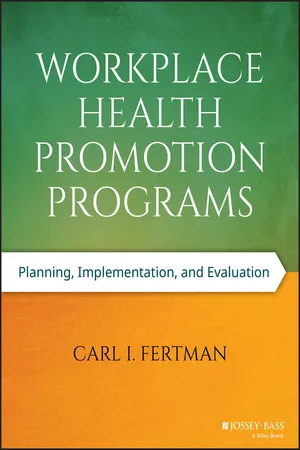
Workplace Health Promotion Programs
Planning, Implementation, and Evaluation
- English
- ePUB (mobile friendly)
- Available on iOS & Android
About This Book
Shine a spotlight on the benefits of promoting health in the workplace
Workplace Health Promotion Programs focuses on the incredible value that employee health programs can offer by exploring six key topics: behavioral health, physical health, healthy environments, health education, nutritional health, and physical activity. This in-depth resource explicitly establishes what successful workplace health promotion programs, services, and collaborations are, and then builds upon this foundational understanding by introducing methods and tools for promoting employee health and safety, while emphasizing the skills students need to do so. Through this resource, students will come to understand how to recognize employee health and safety opportunities, and how to think on a larger scale when it comes to workplace health initiatives in small, midsized, and larger employers that are comprehensive and fiscally sound.
Workplace health promotion programs have the potential to both improve the health of the population as a whole and control healthcare spending in the process. Health problems are estimated to cost employers in the United States over $200 billion per year through medical costs, absenteeism, disability, and overall reduced productivity. Improving well-being through effective workplace health promotion programs can reduce this cost—and create healthier, happier workforces.
- Discover the design, implementation, and evaluation of workplace health promotion programs that address the range of employee health needs and concerns
- Understand how evidence-based programs can positively impact business and reduce health care cost
- Explore the larger scale implications of successful workplace health programs, including health policies, health insurance design, worker safety, employee behavior, etc.
- Learn how together employers and employees work to create a culture of health and well-being to support and promote employee health and safety
- Review the ways in which successful workplace health promotion programs can prove financially beneficial
Workplace Health Promotion Programs is a resource that guides students and professionals alike in the discovery, development, and execution of successful employee health initiatives.
Frequently asked questions
Information
Part One
Foundation
Chapter 1
Workplace Health Promotion Program Foundations
Learning Objectives
- Define workplace health promotion programs
- Summarize the historical context for workplace health promotion
- Discuss the impact of the Affordable Care Act on workplace health promotion
- Identify workplace health promotion controversies and pitfalls
What Are Workplace Health Promotion Programs?
- Having an organizational commitment to improving the health of the workforce
- Providing employees with appropriate information and establishing comprehensive communication strategies
- Involving employees in decision-making processes
- Developing a working culture that is based on partnership
- Organizing work tasks and processes so that they contribute to, rather than damage, health
- Implementing policies and practices that enhance employee health by making the healthy choices the easy choices
- Recognizing that organizations have an impact on people and that this is not always conducive to their health and well-being
Historical Context for Workplace Health Promotion
First Phase
Table of contents
- Cover
- Title Page
- Copyright
- Table of Contents
- Dedication
- Figures, Tables, Boxes, and Exhibits
- Preface
- Acknowledgments
- About the Author
- Part One: Foundation
- Part Two: Planning
- Part Three: Implementation
- Part Four: Evaluation
- Part Five: Workplaces
- Index
- End User License Agreement